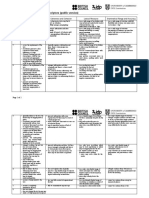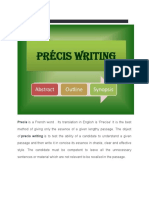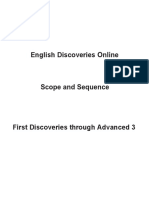0 ratings0% found this document useful (0 votes)
58 viewsKriteria Penskoran Writing Analyical Exposition
The document outlines criteria for scoring writing and speaking assessments in five areas:
1) Content, 2) Organization, 3) Sentence Structure, 4) Vocabulary and Style, and 5) Mechanics or Pronunciation. Each area is scored from 1 to 5, with 5 being the highest score for effectively addressing the criteria described. Descriptions are provided for each score level to illustrate what is required to receive that score.
Uploaded by
abdul ajangCopyright
© © All Rights Reserved
Available Formats
Download as DOCX, PDF, TXT or read online on Scribd
0 ratings0% found this document useful (0 votes)
58 viewsKriteria Penskoran Writing Analyical Exposition
The document outlines criteria for scoring writing and speaking assessments in five areas:
1) Content, 2) Organization, 3) Sentence Structure, 4) Vocabulary and Style, and 5) Mechanics or Pronunciation. Each area is scored from 1 to 5, with 5 being the highest score for effectively addressing the criteria described. Descriptions are provided for each score level to illustrate what is required to receive that score.
Uploaded by
abdul ajangCopyright
© © All Rights Reserved
Available Formats
Download as DOCX, PDF, TXT or read online on Scribd
You are on page 1/ 2
KRITERIA PENSKORAN WRITING ANALYICAL EXPOSITION
NO ASPEK DESKRIPSI SKOR
Relevant to the topic. Support main idea convincingly with specific, 5
appropriate example/reason/evidence
1 Content Relevant to the topic. Support main idea adequately with specific, 4
appropriate example/reason/evidence
Mostly relevant to the topic. Support main idea but few points are 3
too general/ abstract/vague.
Generally address the topic . Lack use of specific, appropriate 2
example/reason/evidence.
Main idea is not clear. No use of specific, appropriate 1
example/reason/evidence.
Focuses on the main idea with well-organized and well-elaborated 5
text.
2 Organisation Focuses on the main idea and well-organized but not well- 4
elaborated.
Focuses on the main idea but not well-organized and not well- 3
elaborated.
Not focus on the main idea, sometimes has more than one main idea, 2
unwell-organized and unwell-elaborated.
The main idea is not clear, lack of elaboration 1
Effective word order, no jumbled words, no mistakes in: tense, word 5
order, articles, pronoun, and preposition.
3 Sentence Standard word order, no jumbled words, few mistakes in: tense, 4
Formatting and word order, articles, pronoun, and preposition.
Usage Generally, standard word order, some jumbled words, some 3
mistakes in: tense, word order, articles, pronoun, and preposition.
Some standard word order, some jumbled words, many mistakes in: 2
tense, word order, articles, pronoun, and preposition.
Frequent standard word order, some jumbled words, many mistakes 1
in: tense, word order, articles, pronoun, and preposition.
Well-chosen vocabulary, sentence variety and information. 5
Vocabulary is precise and the information is purposeful. 4
4 Vocabulary Vocabulary is less precise and the information is less purposeful. 3
and Style Use only basic vocabulary and not purposefully selected. Its tone is 2
flat or not consistent.
Unwell-chosen vocabulary, sentence variety and information. The 1
meaning also vague.
Effective use of capitalization, punctuation, spelling and formatting. 5
Few (if any) noticeable error in capitalization, punctuation, spelling 4
and formatting.
Generally, almost use effective capitalization, punctuation, spelling 3
5 Mechanic and formatting. If there is any error, it does not detract from
meaning.
Several errors in spelling and punctuation which detract from 2
meaning.
Many misspell in simple words. 1
KRITERIA PENSKORAN SPEAKING
NO ASPEK DESKRIPSI SKOR
Relevant to the topic. Support main idea convincingly with specific, 5
appropriate example/reason/evidence
1 Content Relevant to the topic. Support main idea adequately with specific, 4
appropriate example/reason/evidence
Mostly relevant to the topic. Support main idea but few points are 3
too general/ abstract/vague.
Generally address the topic . Lack use of specific, appropriate 2
example/reason/evidence.
Main idea is not clear. No use of specific, appropriate 1
example/reason/evidence.
Focuses on the main idea with well-organized and well-elaborated 5
text.
2 Organisation Focuses on the main idea and well-organized but not well- 4
elaborated.
Focuses on the main idea but not well-organized and not well- 3
elaborated.
Not focus on the main idea, sometimes has more than one main 2
idea, unwell-organized and unwell-elaborated.
The main idea is not clear, lack of elaboration 1
Well-chosen vocabulary, sentence variety and information. 5
Vocabulary is precise and the information is purposeful. 4
4 Vocabulary Vocabulary is less precise and the information is less purposeful. 3
and Style Use only basic vocabulary and not purposefully selected. Its tone is 2
flat or not consistent.
Unwell-chosen vocabulary, sentence variety and information. The 1
meaning also vague.
Native like pronunciation and fluency 5
Few (if any) noticeable error in pronunciation 4
Pronunciation Generally, almost use correct pronunciation. If there is any error, it 3
does not detract from meaning.
5 Several errors in pronunciation which detract from meaning. 2
Many mispronounce in simple words. 1
You might also like
- The Best Little Grammar Book Ever!: 101 Ways to Impress With Your Writing and SpeakingFrom EverandThe Best Little Grammar Book Ever!: 101 Ways to Impress With Your Writing and Speaking2.5/5 (3)
- Content Organization Sentence Structure Vocabulary Conventions 5No ratings yetContent Organization Sentence Structure Vocabulary Conventions 51 page
- Sách - Ielts Writing Task 2 For IntermediateNo ratings yetSách - Ielts Writing Task 2 For Intermediate61 pages
- Sách - Ielts Writing Task 2 For IntermediateNo ratings yetSách - Ielts Writing Task 2 For Intermediate61 pages
- General Writing Rubric: No No, But Yes, But YesNo ratings yetGeneral Writing Rubric: No No, But Yes, But Yes1 page
- Language Intelligence or Universal English: Remedy Your Language Habits Book 2From EverandLanguage Intelligence or Universal English: Remedy Your Language Habits Book 2No ratings yet
- "Speak Clearly: Mastering the Most Difficult Words to Pronounce Correctly"From Everand"Speak Clearly: Mastering the Most Difficult Words to Pronounce Correctly"No ratings yet
- Language Intelligence or Universal English: Remedy Your Speech Skills Book 3From EverandLanguage Intelligence or Universal English: Remedy Your Speech Skills Book 3No ratings yet
- Exemplary Proficient Developing Beginning: Analytical Writing RubricNo ratings yetExemplary Proficient Developing Beginning: Analytical Writing Rubric1 page
- Ielts Task 2 Writing Band Descriptors 240223 105507No ratings yetIelts Task 2 Writing Band Descriptors 240223 1055073 pages
- When Bad Grammar Happens to Good People: How to Avoid Common Errors in EnglishFrom EverandWhen Bad Grammar Happens to Good People: How to Avoid Common Errors in EnglishNo ratings yet
- Marking Criteria - Composition, Summary, LiteratureNo ratings yetMarking Criteria - Composition, Summary, Literature3 pages
- School of Foreign Languages Writing Assessment Criteria (Paragraph)No ratings yetSchool of Foreign Languages Writing Assessment Criteria (Paragraph)1 page
- Intuitive German Mastery: Harnessing AI Principles for Smarter Language LearningFrom EverandIntuitive German Mastery: Harnessing AI Principles for Smarter Language LearningNo ratings yet
- 3rd-5th Grade Narrativereflective Narrative Writing 1No ratings yet3rd-5th Grade Narrativereflective Narrative Writing 11 page
- Korean Conversations and Debating: A Language Guide for Self-Study or Classroom Use--Learn to Talk About Current Topics in Korean (With Companion Online Audio)From EverandKorean Conversations and Debating: A Language Guide for Self-Study or Classroom Use--Learn to Talk About Current Topics in Korean (With Companion Online Audio)No ratings yet
- Essay Rubric: Score Quality of Ideas Organization Writing StyleNo ratings yetEssay Rubric: Score Quality of Ideas Organization Writing Style1 page
- Daily Lesson Plan 13: Week DAY Date Class Subject TimeNo ratings yetDaily Lesson Plan 13: Week DAY Date Class Subject Time6 pages
- AHElect Student Module 1 - Enrichment of Academic VocabularyNo ratings yetAHElect Student Module 1 - Enrichment of Academic Vocabulary7 pages
- Spelling Tracker - Rule 24 - Able Ible Ably IblyNo ratings yetSpelling Tracker - Rule 24 - Able Ible Ably Ibly6 pages
- Annual Distribution For 2AS Lit - PH 2022 2023No ratings yetAnnual Distribution For 2AS Lit - PH 2022 20232 pages
- Nigeria Socio-Cultural Influence On The Nigerian English LanguageNo ratings yetNigeria Socio-Cultural Influence On The Nigerian English Language4 pages
- Chambers S Etymological Dictionary of THNo ratings yetChambers S Etymological Dictionary of TH611 pages
- Marie M. Clay's Theoretical PerspectiveNo ratings yetMarie M. Clay's Theoretical Perspective21 pages
- English10 Q4 Module 3 Expanded Definition 1No ratings yetEnglish10 Q4 Module 3 Expanded Definition 119 pages
- A Contrastive Study of English and Annang Structural PatternsNo ratings yetA Contrastive Study of English and Annang Structural Patterns22 pages
- Translation of IFRS Standards Into Local Languages: Understanding Problematics of TranslationNo ratings yetTranslation of IFRS Standards Into Local Languages: Understanding Problematics of Translation26 pages
- ENGL 444 - Lesson 2 - Initial Concepts - LSNo ratings yetENGL 444 - Lesson 2 - Initial Concepts - LS40 pages

























































































